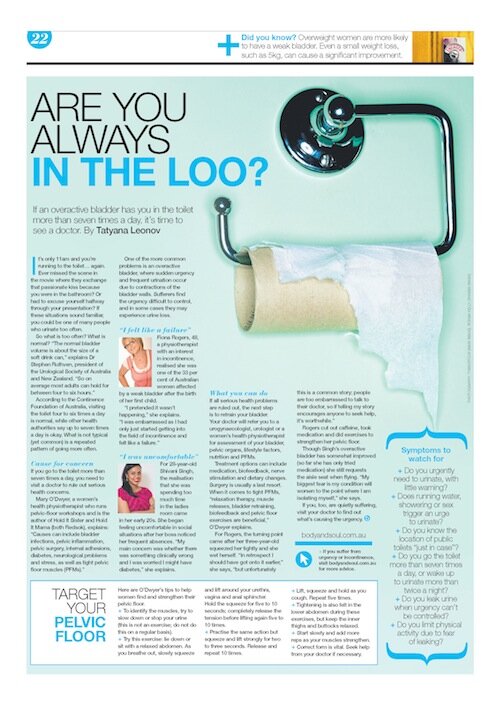Are You Always in the Loo?
If an overactive bladder has you in the toilet more than seven times a day, it's time to see a doctor.
It's only 11am and you're running to the toilet… again. Ever missed the scene in the movie where they exchange that passionate kiss because you were in the bathroom? Or had to excuse yourself halfway through your presentation? If these situations sound familiar, you could be one of many people who urinate too often.
So what is too often? What is normal? "The normal bladder volume is about the size of a soft drink can," explains Dr Stephen Ruthven, president of the Urological Society of Australia and New Zealand. "So on average most adults can hold for between four to six hours."
According to the Continence Foundation of Australia, visiting the toilet four to six times a day is normal, while other health authorities say up to seven times a day is okay. What is not typical (yet common) is a repeated pattern of going more often.
Cause for concern
If you go to the toilet more than seven times a day, you need to visit a doctor to rule out serious health concerns.
Mary O’Dwyer, a women’s health physiotherapist who runs pelvic-floor workshops and is the author of Hold It Sister and Hold It Mama (both Redsok), explains: “Causes can include bladder infections, pelvic inflammation, pelvic surgery, internal adhesions, diabetes, neurological problems and stress, as well as tight pelvic floor muscles (PFMs).”
One of the more common problems is an overactive bladder, where sudden urgency and frequent urination occur due to contractions of the bladder walls. Sufferers find the urgency difficult to control, and in some cases they may experience urine loss.
“I felt like a failure”
Fiona Rogers, 48, a physiotherapist with an interest in incontinence, realised she was one of the 33 per cent of Australian women affected by a weak bladder after the birth of her first child.
“I pretended it wasn’t happening,” she explains. “I was embarrassed as I had only just started getting into the field of incontinence and felt like a failure.”
“I was uncomfortable”
For 28-year-old Shivani Singh, the realisation that she was spending too much time in the ladies room came in her early 20s. She began feeling uncomfortable in social situations after her boss noticed her frequent absences. “My main concern was whether there was something clinically wrong and I was worried I might have diabetes,” she explains.
What you can do
If all serious health problems are ruled out, the next step is to retrain your bladder. Your doctor will refer you to a urogynaecologist, urologist or a women’s health physiotherapist for assessment of your bladder, pelvic organs, lifestyle factors, nutrition and PFMs.
Treatment options can include medication, biofeedback, nerve stimulation and dietary changes. Surgery is usually a last resort. When it comes to tight PFMs, “relaxation therapy, muscle releases, bladder retraining, biofeedback and pelvic floor exercises are beneficial,” O’Dwyer explains.
For Rogers, the turning point came after her three-year-old squeezed her tightly and she wet herself. “In retrospect I should have got onto it earlier,” she says, “but unfortunately this is a common story; people are too embarrassed to talk to their doctor, so if telling my story encourages anyone to seek help, it’s worthwhile.”
Rogers cut out caffeine, took medication and did exercises to strengthen her pelvic floor.
Though Singh’s overactive bladder has somewhat improved (so far she has only tried medication) she still requests the aisle seat when flying. “My biggest fear is my condition will worsen to the point where I am isolating myself,” she says.
If you, too, are quietly suffering, visit your doctor to find out what’s causing the urgency.
Symptoms to watch for
+ Do you urgently need to urinate, with little warning?
+ Does running water, showering or sex trigger an urge to urinate?
+ Do you know the location of public toilets “just in case”?
+ Do you go the toilet more than seven times a day, or wake up to urinate more than twice a night?
+ Do you leak urine when urgency can’t be controlled?
+ Do you limit physical activity due to fear of leaking?
TARGET YOUR PELVIC FLOOR
Here are O’Dwyer’s tips to help women find and strengthen their pelvic floor.
+ To identify the muscles, try to slow down or stop your urine (this is not an exercise; do not do this on a regular basis).
+ Try this exercise: lie down or sit with a relaxed abdomen. As you breathe out, slowly squeeze
and lift around your urethra, vagina and anal sphincter. Hold the squeeze for five to 10 seconds; completely release the tension before lifting again five to 10 times.
+ Practise the same action but squeeze and lift strongly for two to three seconds. Release and repeat 10 times.
+ Lift, squeeze and hold as you cough. Repeat five times.
+ Tightening is also felt in the lower abdomen during these exercises, but keep the inner thighs and buttocks relaxed.
+ Start slowly and add more reps as your muscles strengthen.
+ Correct form is vital. Seek help from your doctor if necessary.






